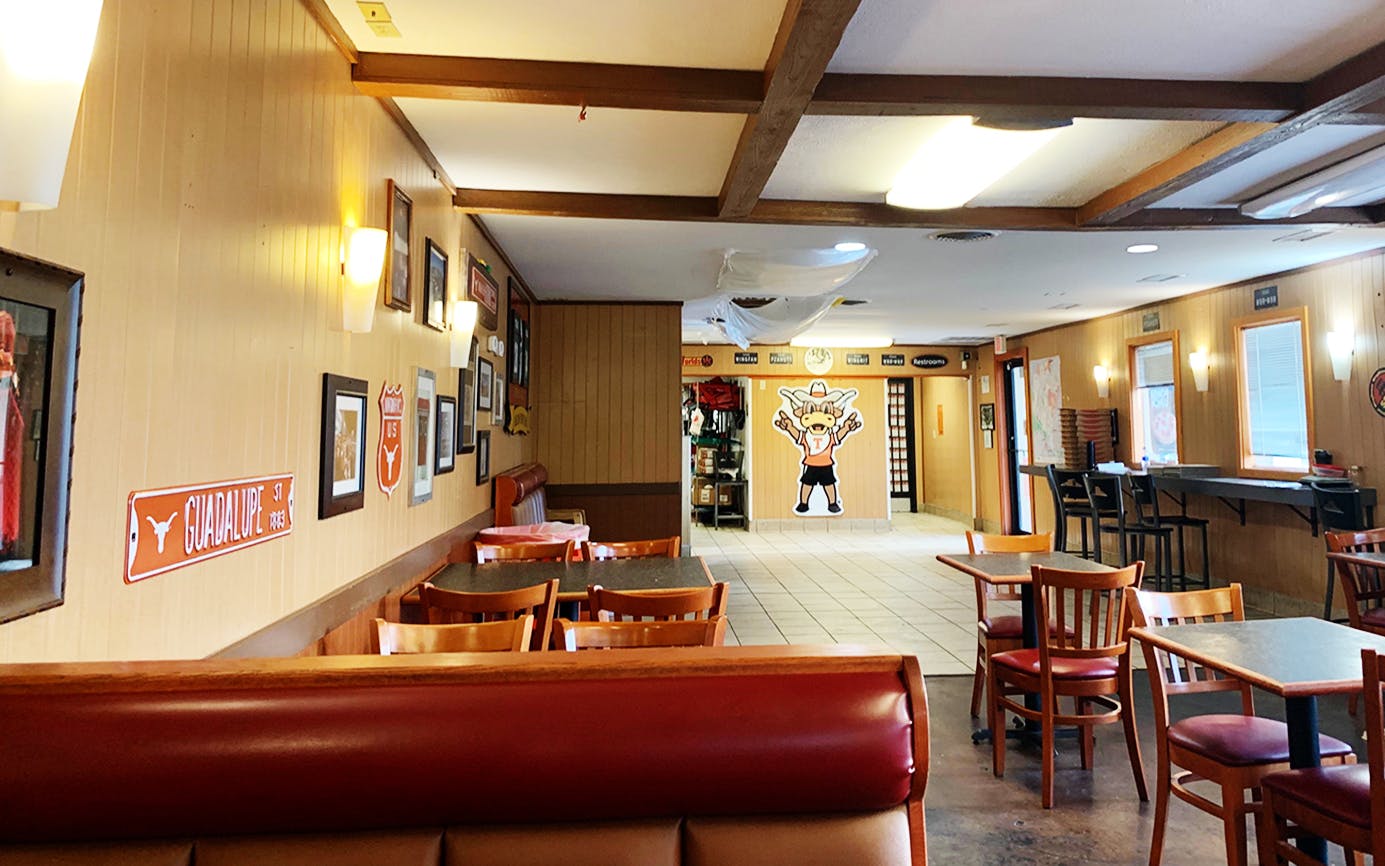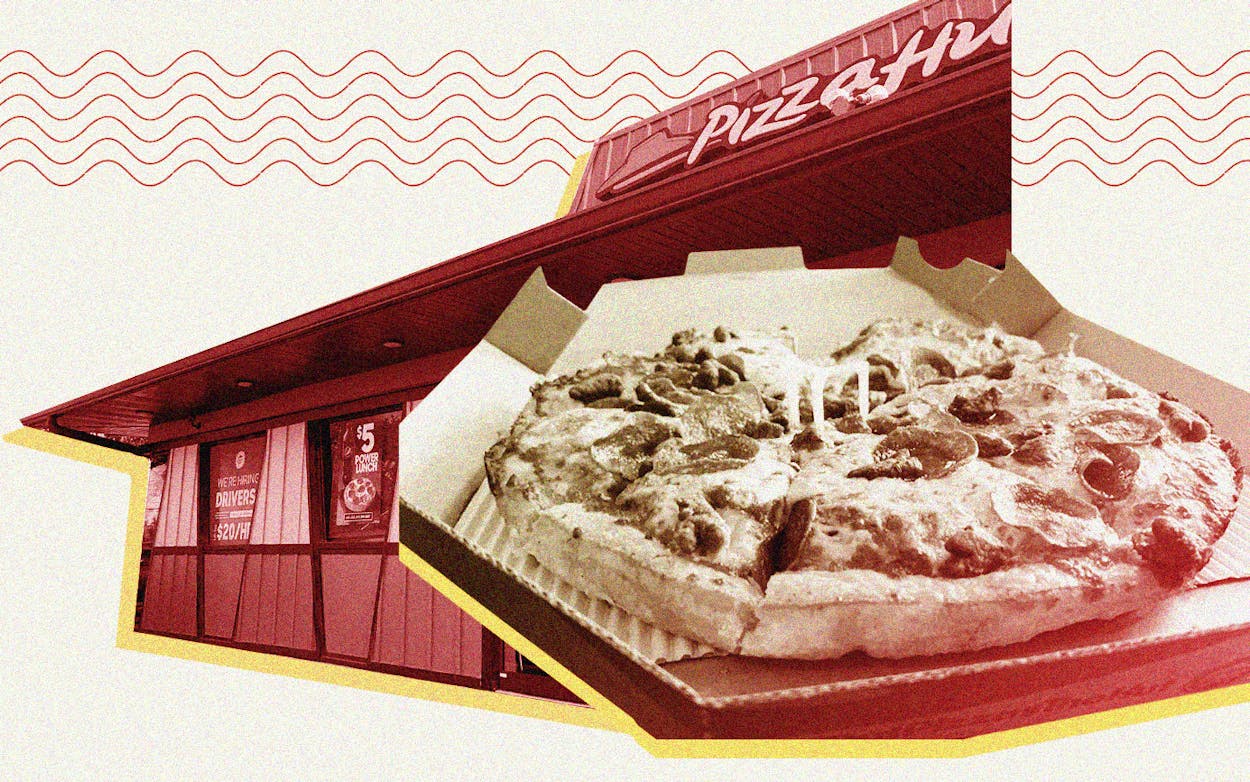Pizza Hut’s stout, rectangular storefront—replete with a red thatched roof and a raised strip at the peak of its gable—immediately conjures nostalgia for the Stranger Things era. And while there are other fast food chains with a distinctive architectural identity, the Plano-based restaurant’s iconic building style has been built right into its name.
In the seventies, the company ditched its original mascot—a cartoon character named “Pizza Pete”—for a logo that made the store’s name appear to be wearing a red hat. Pizza Hut was beloved by suburban kids into the next decade, because some of the tables also doubled as Pac-Man games. In the nineties, its “Book It” program meant that reading enough books in school would get kids a free personal pizza. The stores started to close in the aughts, as the brand began to transition into the Pizza Hut Express brand, a fast-food version of the restaurant found in malls and airports, and standalone locations. There were joint ventures with other restaurants under the Yum! Foods brand—the infamous combination Pizza Hut and Taco Bell—and a renewed focus on carry-out and delivery locations, without a dine-in section or the iconic architecture.
Even as Pizza Hut stores have closed over the years, the building shape remains—the Used to be a Pizza Hut blog tracks the former franchises, while the blog Not Fooling Anybody documents the more egregious failed conversions. But soon, there’ll be even fewer dine-in Pizza Huts. Earlier this month, the chain announced that it would be closing five hundred of its dine-in locations. The change comes as the company has converted many previous dine-in locations to become carry-out only spots, too—which means that the era of the dine-in Pizza Hut may well be ending sooner than later.
I hadn’t eaten at a dine-in Pizza Hut in years before I heard the news, which meant that I was, presumably, part of the problem. I decided that I should go say goodbye to the experience, if nothing else. I knew of one hat-shaped building in North Austin, and decided I’d drive over—but when I got there, I learned I was already too late. The building’s exterior was virtually unchanged since the nineties, but inside, the entire front half of the restaurant had been sealed off. It was already carry-out only. I had no idea what they were even using the rest of the space for, and it was my mistake for assuming that the classic Pizza Hut building meant a classic Pizza Hut experience.

Just three dine-in Pizza Huts remain in Austin, with three more on the city’s outskirts (in Pflugerville, Georgetown, and Taylor). The closest one to me was the most central, across from the University of Texas campus on MLK and Guadalupe. I had been to that location before—when I lived within walking distance, I would sometimes stop in for the buffet—but it was different from what I encountered. There was no buffet, and no table service. I ordered a pizza and retrieved a 20-ounce soda from the cooler, and paid at the counter before claiming a table. I was the only customer in the restaurant at 6:30 on a weeknight.
It was summer, I figured, so maybe the students were all out of town. But after about ten minutes, my name was called, and my pizza was handed to me in a box. There weren’t any plates, silverware, or napkins out. The vibe was decidedly less “this is a dine-in restaurant” and more “we won’t kick you out if you try to eat that here.” And they didn’t, though I’m not sure they even knew I was still there.
I had hoped going there would conjure up some memories of Pizza Hut experiences past. I knew the “Book It” era had passed—even if, in 2014, the company briefly sponsored an “alumni” program that gave rewards to adults for reading—but sitting in the sad Pizza Hut, still technically listed as a dine-in location on their website even if nobody bothered to tell the staff, didn’t really come close to matching what lived in my memory.
That’s a normal part of being an adult, though. It’s 2019, and Pizza Hut’s dine-in business has been struggling for years. That’s not a surprise, and it’s not unique to Pizza Hut—casual dining chains are struggling across the board. Pizza Hut is probably in a tougher spot than its North Texas neighbors Chili’s and T.G.I. Friday’s, since people who just wanted to eat their pizza could have it delivered to their house. I stopped going to Pizza Hut ages ago, once I didn’t live in the suburbs and had more access to places I liked better. The numbers tell us I wasn’t alone in that—so why would I expect the Pizza Hut experience to have been unchanged as all that time had passed, even as I knew they were closing stores?
I was sad when I heard the news, because I enjoyed going to Pizza Hut when I was little. When I was a kid, my family didn’t eat at restaurants with table service very often, but Pizza Hut was sort of an in-between space, so it felt special. As a teen, I liked that I could go with a group of friends and split a couple of pizzas that didn’t cost much. The experience may have never been great, but it was a part of the sort of suburban childhood I had, and one that’s probably not long for this world. But the world moved past Pizza Hut, Pizza Hut moved past me, and ultimately, there are places I’d rather go, anyway. At some point, watching these artifacts of your childhood fade is just a part of growing up.








